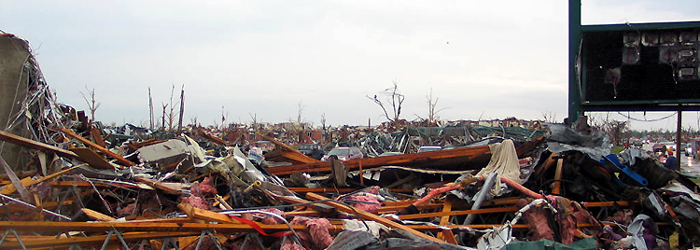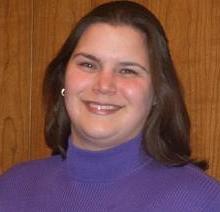Creating Action-Inspiring Tornado Warnings

Image showing damage from the tornado that hit Joplin, Mo., on May 22, 2011.
Image credits: NOAA
(Inside Science) -- One year ago this week, 158 people died when a tornado with winds greater than 200 mph struck Joplin, Mo. Even though the National Oceanic and Atmospheric Administration issued tornado warnings and activated siren alerts ahead of time, it was clear that some people ignored, disregarded or waited too long to react to them. As meteorologists continue to learn more about tornado formation and improve their forecasting, they are also working to improve how warnings are communicated to and received by the public.
When meteorologists recognize atmospheric conditions that can spawn a tornado, a severe thunderstorm and tornado watch are issued. But that information can be frustratingly vague for the audience.
"We need to understand how and why some thunderstorms produce tornadoes and some don't," said Paul Schlatter, a severe weather and radar expert with NOAA’s National Weather Service. "I
This uncertainty makes the job of communicating weather emergency information a challenge.
"Some people ignore severe thunderstorm warnings because those are perceived to be ‘not as bad' as tornado warnings," said Paul Gross, a broadcast meteorologist at WDIV-TV, the NBC affiliate in Detroit. "Some viewers are almost desensitized when it comes to significant weather and combine this with a somewhat higher false alarm rate with radar-based tornado warnings and some people simply don't trust the warnings anymore."
During the storm that produced the deadly tornado, Joplin residents were active in gathering weather information.
"My research suggests that pre-event awareness was critical," said Kim Klockow, a graduate student at the University of Oklahoma's Department of Geography and Environmental Stability. "Most of my interviewees [Joplin residents] were actively monitoring, seeking, and interpreting weather information from multiple sources and they weren't actively discrediting this information."
So why would people armed with a tornado warning and tornado sirens blaring still decide to wait to seek shelter?
"As I see it, there are two knowledge sets that are competing with one another, and the negotiation of these knowledges as tornadoes approach is complex," said Klockow.
One set of knowledge is the tornado warning and another is a set of "folk science" beliefs. Folk science is often passed down from generation to generation and sometimes it does have a basis in fact, but conventional science can often dispel false notions, such as the idea that tornadoes can't cross water.
"At a certain point, people could easily believe the warnings, in that they believed a tornado was happening and it could possibly go nearby, but they did not personalize the risk to themselves until some critical threshold in space, or with respect to certain landmarks, was reached," said Klockow. "We need to understand what people think of when they hear about warnings, what information they seek, and why."
So what can atmospheric scientists and broadcast meteorologists do to improve tornado watch and warning information? NOAA has launched the Weather-Ready Nation campaign in efforts to better prepare U.S. communities for weather-related disasters.
"We are working with social scientists to help us understand what the public hears when they hear a warning and what makes them take it seriously," said Schlatter.
Since 2010, a group of researchers with NOAA's National Severe Storms Laboratory and the University of Oklahoma have been working on developing a "Warn-on-Forecast" with the goal of being able to warn 60 minutes ahead of severe weather events. Last week, the National Weather Service announced a Wireless Emergency Alerts system for compatible wireless devices.
"[The alerts] will add to the wide variety of ways people can receive weather warnings, but what makes them unique is they are automatic, free and instant," said Susan Buchanan, a spokesperson at the weather service. "Alerts will be sent directly from the National Weather Service to smart phones within range of a cell tower where a warning is in effect."
On April 13, 2012, when meteorologists at the Storm Prediction Center in Norman, Okla. spotted a strong storm system developing over Kansas, Oklahoma, and Nebraska they issued a high-risk warning -- for the second time in history -- a full 24 hours in advance of a tornado. This early announcement was credited with saving lives.
"When you hear a warning, take it seriously and take action," said Schlatter. "It isn't worth the risk."

